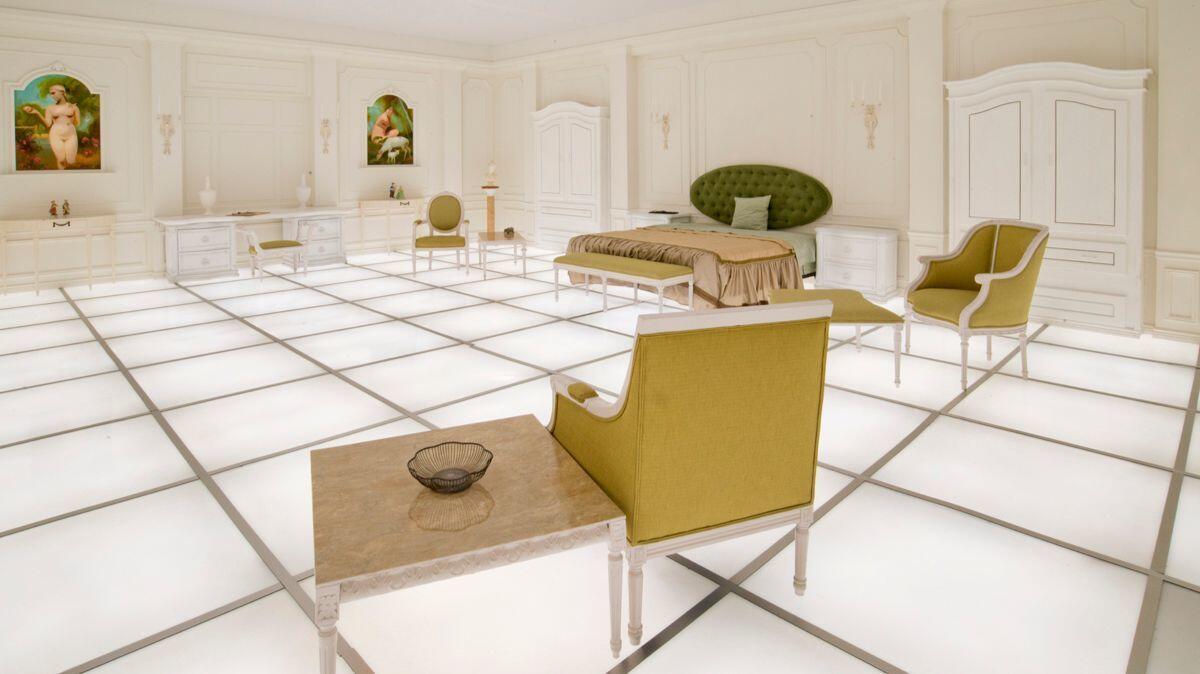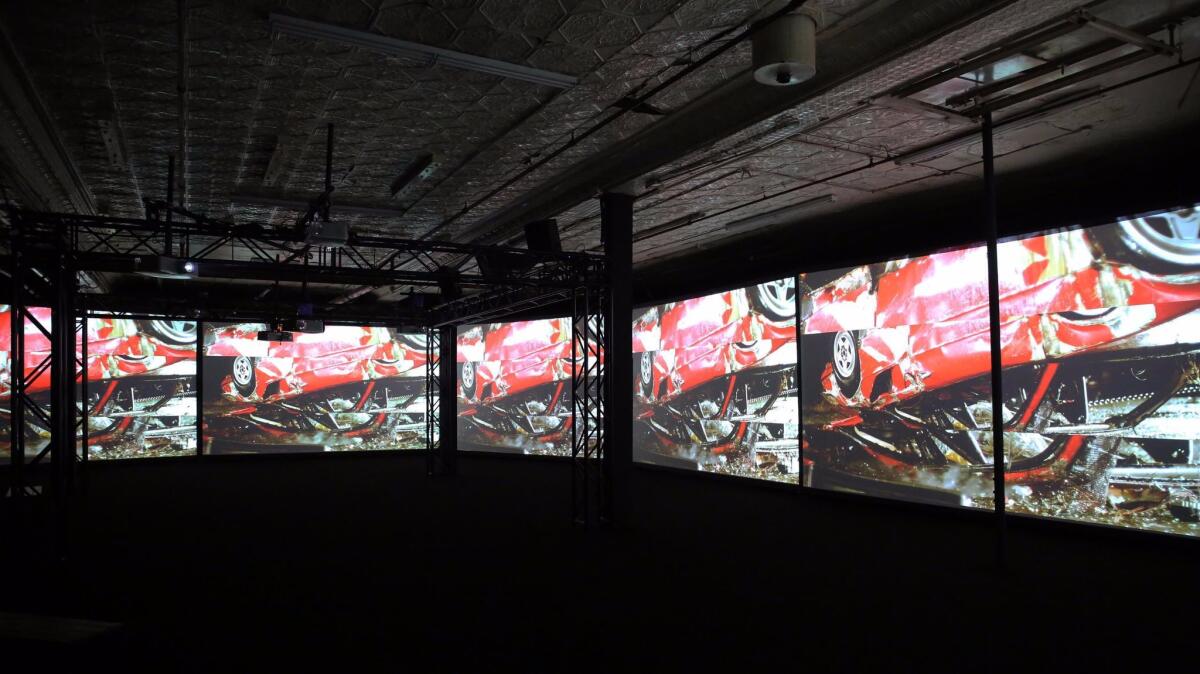Review: ‘The 14th Factory’ art exhibition, despite all the hype, is just an $18 ticket to spectacle
- Share via
On a sunny Sunday morning, Simon Birch, the creator of the art exhibition “The 14th Factory,” is using a skimmer to clean the surface of a large pool. The shallow water is improbably studded with the tails of airplanes. They tower above him like giant shark fins as he says, “This is not performance art.”
It’s true, contemporary art can be a slippery beast. Sometimes it’s hard to tell what’s art and what’s just keeping the pool clean.

“The 14th Factory” is a herculean vanity project in which everything fairly shouts “Art!” The brainchild of the British-born, Hong Kong-based Birch, the exhibition — by virtue of its location in a warehouse complex in Lincoln Heights and lack of institutional support — claims to establish a “new, independent paradigm for socially-engaged art.”
This “paradigm” has been a social media hit, prompting a long segment on public radio station KPCC. The Huffington Post wrote of Birch, “His ideas definately [sic] warrant critical acclaim,” and L.A. Weekly touted the exhibition as the work of a nonprofit creating “art experiences that serve as vehicles for social change.”
This all follows a 2015 New York Times feature about a $3-million “14th Factory” exhibition opening in Manhattan in April 2016 — followed by an article announcing that the exhibition would not be opening after all.
Now “The 14th Factory” is here. But does it engage the site or audience, and is there anything really new about it? Selfie-bait installations and slickly produced video projections have long been staples of the international biennial and art fair circuit.
Birch has organized a labyrinth of immersive, multimedia experiences. If art were a ride, I’m pretty sure it would look like “The 14th Factory.”
The spectacle is structured as a hero’s journey, the narrative archetype popularized by mythologist Joseph Campbell in which a protagonist ventures into unknown territory to bring back boons for civilization. But the show only addresses transcendence and transformation in simplistic ways, celebrating an old-fashioned, maddeningly generic notion of humanity.

SIGN UP for the free Essential Arts & Culture newsletter »
The first large installation is a dark, cavernous room filled with an enormous jumble of jagged wall fragments, all painted black. At the center of this quite literal depiction of chaos and destruction is a glowing white room, a replica of a chamber from the film “2001: A Space Odyssey.” It’s a highly convincing reproduction that would be chilling if its entrance weren’t thronged with eager viewers queuing for selfies.
Next comes a large, brightly lighted space, in the center of which is a field of grass. Or rather, it was a field of grass. After a month of wear and tear, it is a field of dirt and trampled, brownish vegetation. Did I mention there are swings? The space seems intended as an idyllic respite from the “chaos” of the previous room, but instead looks as tired as its premise.
The rest of the show is packed with paintings and photographs, sculptures and installations, none of which take advantage of the building’s history. I was sad to see a neat old industrial scale entirely ignored in another dark room full of enormous video screens. Although the show claims to honor the building’s industrial heritage, it instead romanticizes that heritage without really engaging it.

The most gratuitous work in the show is a six-channel video — why six channels when two or three would do? — recording the destruction of a Ferrari as it tumbles across the pavement. The piece, which is skillfully shot and full of fancy effects, evokes the fascination with speed and violence espoused by the Futurist artists of the early 20th century. These artists were famously associated with Italian fascism. Can it be a coincidence that the car is Italian? The work’s seductive polish is disconcerting in light of its fixation on destruction.
As if the video weren’t enough, the next room is lined with highly aesthetic, close-up photographs of the damage. These are hung on either side of a long table bearing actual pieces of the car. Birch says that the work makes the car even more valuable by turning it into art. That may be true, but it’s art that says, at best: “Can you believe I did this?” And at worst, it desensitizes us to violence by turning it into an attractive spectacle.
♦ ♦ ♦ ♦ ♦ ♦ ♦ ♦ ♦ ♦
‘The 14th Factory’
Where: 440 N. Ave. 19, L.A.
When: Closed Mondays
Admission: $13.50-$18
Information: www.the14thfactory.com
Support coverage of SoCal arts. Share this article.
ALSO
At LACMA, the horror of 9/11 through the eyes of a Muslim artist who found a different path
Beverly Center as art gallery? Big-name artists are behind those construction barricades
The exhibition that has art fans in a fury: Our critic's take on MOCA's Carl Andre retrospective
A groundbreaking show to confront the gender bias in art: 'Women of Abstract Expressionism'
The biggest entertainment stories
Get our big stories about Hollywood, film, television, music, arts, culture and more right in your inbox as soon as they publish.
You may occasionally receive promotional content from the Los Angeles Times.







